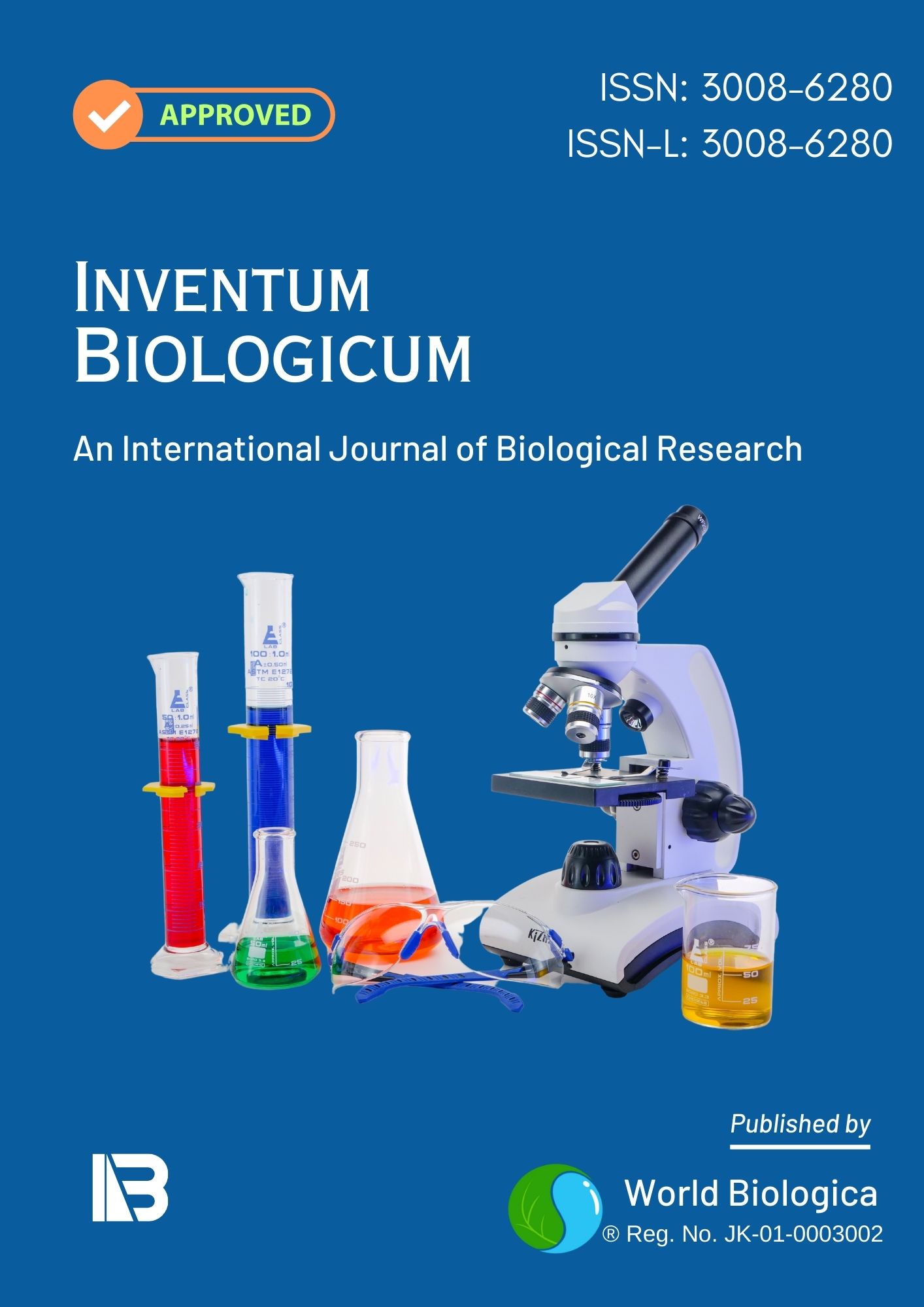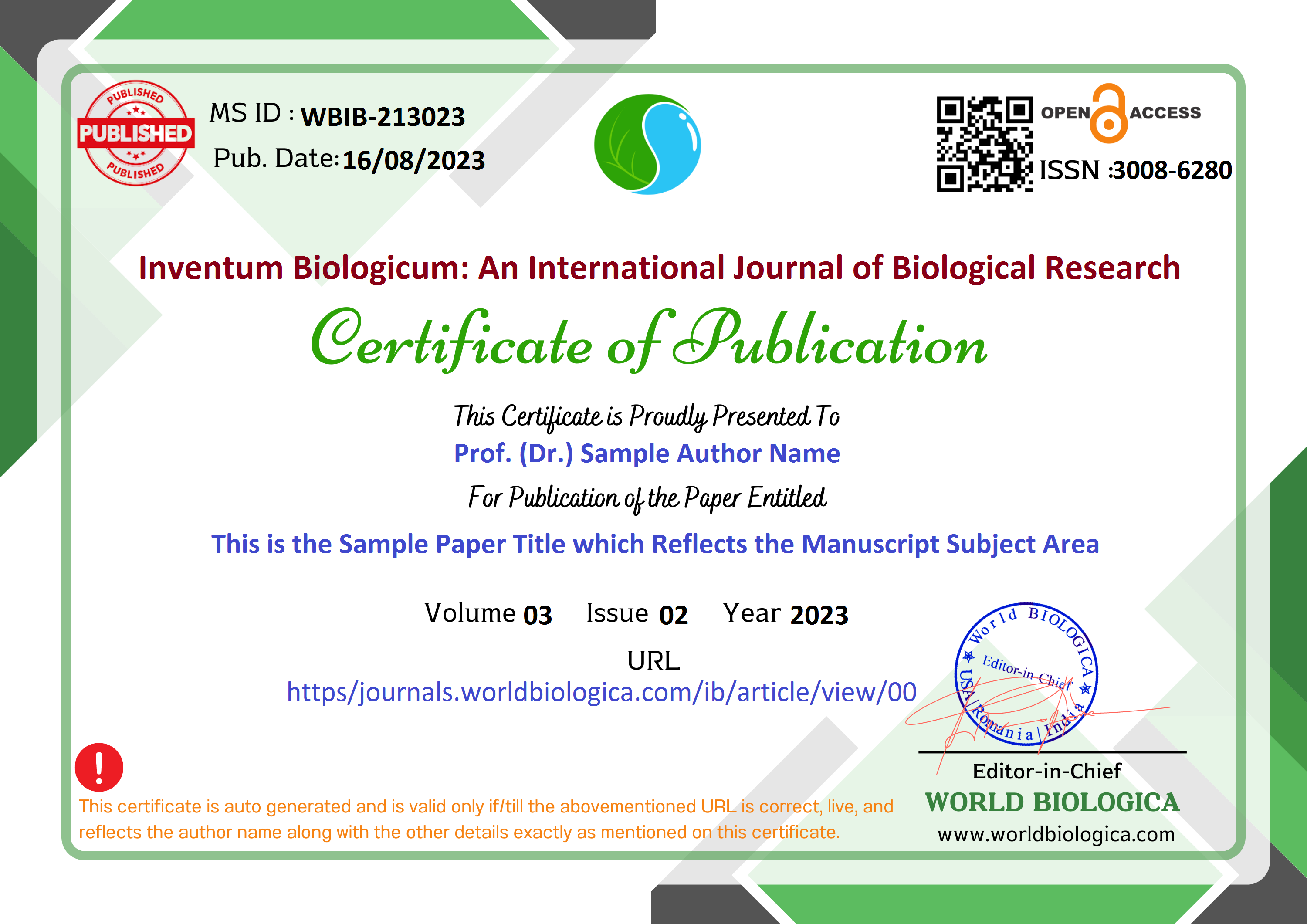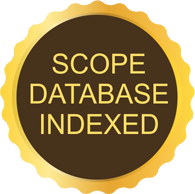Cardio-Metabolic Ailments Treated by the Non-Institutionally Trained Siddha Practitioners of Virudhunagar District of Tamil Nadu, India
Keywords:
Ethnomedicinal knowledge, Siddha medicine, Cardio-metabolic disorders, Medicinal plants, Traditional healers, Virudhunagar districtAbstract
The Siddha system of medicine, originating in Tamil Nadu, India, is a traditional practice recognized for its effectiveness in managing cardio-metabolic disorders, including diabetes, hypertension, and cardiovascular diseases. This study explores the ethnomedicinal knowledge of 65 non-institutionally trained Siddha practitioners in Virudhunagar district, who were interviewed from July 2021 to April 2023 using semi-structured questionnaires. The practitioners identified 83 plant species from 45 botanical families, with the most cited being Gymnema sylvestre (68%), Aegle marmelos (54%), Andrographis paniculata (49%), Terminalia arjuna (46%), and Phyllanthus emblica (43%). The primary preparations included decoctions (62%), powders (24%), and pastes (14%), administered orally with dosage adjustments based on patient conditions. The socio-demographic analysis revealed that 78% of practitioners were male, with an average age of 55 years, and 65% had inherited their knowledge through family traditions. Furthermore, 71% lacked formal Siddha education, relying solely on ancestral knowledge. A consensus index of 0.75 indicated strong agreement among practitioners on plant use for specific conditions. The study highlights the importance of preserving this undocumented ethnomedicinal knowledge and suggests that integrating these practices into modern healthcare could help address the rising burden of cardio-metabolic disorders in rural India. Further pharmacological studies are recommended to validate the therapeutic potential of these plants.
Downloads
References
Abdillahi, H.S., & Van Staden, J. (2012). South African plants and male reproductive healthcare: Conception and contraception. Journal of Ethnopharmacology, 143 (2), 475-480.
Adhikari, B.N., Joshi, B.P., Shrestha, J., & Bhatta, N.R. (2018). Genetic variability, heritability, genetic advance and correlation among yield and yield components of rice (Oryza sativa L.). Journal of Agriculture and Natural Resources, 1 (1), 149-160.
Agarwal, A., Mulgund, A., Hamada, A., & Chyatte, M.R. (2015). A unique view on male infertility around the globe. Reproductive Biology and Endocrinology, 13 (1), 1-9.
Agarwal, V., Bell, G.W., Nam, J.W., & Bartel, D.P. (2015). Predicting effective microRNA target sites in mammalian mRNAs. eLife, 4, e05005.
Akour, A., Kasabri, V., Afifi, F.U., & Bulatova, N. (2016). The use of medicinal herbs in gynecological and pregnancy-related disorders by Jordanian women: A review of folkloric practice vs. evidence-based pharmacology. Pharmaceutical Biology, 54 (9), 1901-1918.
Abraham, K.M. (2020). How comparable are sodium-ion batteries to lithium-ion counterparts? ACS Energy Letters, 5(11), 3544-3547.
Balamurugan, R., Liu, J.H., & Liu, B.T. (2018). A review of recent developments in fluorescent sensors for the selective detection of palladium ions. Coordination Chemistry Reviews, 376, 196-224.
Bhakshu, L.M., Ratnam, K.V., & Raju, R.V. (2023). An insight of phytochemical and pharmacological prospective of Senna auriculata (L.) Roxb. In Bioactives and Pharmacology of Legumes (pp. 381-415). Apple Academic Press.
Chenniappan, K., & Murugan, K. (2017). Therapeutic and fertility restoration effects of Ionidium suffruticosum on sub-fertile male albino Wistar rats: Effects on testis and caudal spermatozoa. Pharmaceutical Biology, 55 (1), 946-957.
Chellappandian, M., Mutheeswaran, S., Pandikumar, P., & Ignacimuthu, S. (2012). Quantitative ethnobotany of traditional Siddha medical practitioners from Radhapuram taluk of Tirunelveli District, Tamil Nadu, India. Journal of Ethnopharmacology, 143 (2), 540-547.
Dabaja, A.A., & Schlegel, P.N. (2014). Medical treatment of male infertility. Translational Andrology and Urology, 3 (1), 9.
Disticraj, S., & Jayaraman, P. (2015). Ethnobotanical documentation of few medicinal plants in Jawadhu hills in Tiruvannamalai district of Tamil Nadu. Journal of Pharmacognosy and Phytochemistry, 10 (3), 8-11.
Edo, G.I., Onoharigho, F.O., Kasar, K.A., Ainyanbhor, I.E., & Jikah, A.N. (2024). Evaluation of the anti-inflammatory potential of Zingiber officinale on adjuvant-induced arthritis. Advances in Traditional Medicine, 1-10.
Esmaeilinezhad, Z., Barati-Boldaji, R., Brett, N.R., De Zepetnek, J.O.T., Bellissimo, N., Babajafari, S., & Sohrabi, Z. (2019). The effect of synbiotics pomegranate juice on cardiovascular risk factors in PCOS patients: A randomized, triple-blinded, controlled trial. Journal of Endocrinological Investigation, 43, 539-548.
Fahmy, H.M., Saad, E.A.E.M.S., Sabra, N.M., El-Gohary, A.A., Mohamed, F.F., & Gaber, M.H. (2018). Treatment merits of latanoprost/thymoquinone–encapsulated liposome for glaucomatus rabbits. International Journal of Pharmaceutics, 548 (1), 597-608.
Gamble, J.S. (1921). Flora of the Presidency of Madras. West, Newman and Adlard.
Gamble, T.R., Yoo, S., Vajdos, F.F., Von Schwedler, U.K., Worthylake, D.K., Wang, H., McCutcheon, J.P., Sundquist, W.I., & Hill, C.P. (1997). Structure of the carboxyl-terminal dimerization domain of the HIV-1 capsid protein. Science, 278(5339), 849-853.
Geetha, T., Chenoy, R., Stevens, D., & Johanson, R.B. (1995). A multicentre study of perinatal mortality in Nepal. Paediatric and Perinatal Epidemiology, 9 (1), 74-89.
Ganguly, S., & Unisa, S. (2010). Trends of infertility and childlessness in India: Findings from NFHS data. Facts, Views & Vision in ObGyn, 2 (2), 131.
Goshtasebi, A., Sadighi, J., & Jahangiri, K. (2015). Endometriosis and sexual health: A systematic review. Payesh (Health Monitor), 14 (1), 25-40.
Heinrich, B., & Klier, M. (2009). A novel data quality metric for timeliness considering supplemental data.
Heinrich, B.S., Maliga, Z., Stein, D.A., Hyman, A.A., & Whelan, S.P. (2018). Phase transitions drive the formation of vesicular stomatitis virus replication compartments. MBio, 9 (5), 10-1128.
Henry, C.D. (1989). Late Cenozoic Basin and Range structure in western Mexico adjacent to the Gulf of California. Geological Society of America Bulletin, 101 (9), 1147-1156.
Henry, R.J. (1987). Pentosan and (1→ 3), (1→ 4)-β-glucan concentrations in endosperm and wholegrain of wheat, barley, oats and rye. Journal of Cereal Science, 6 (3), 253-258.
Inhorn, M.C., & Patrizio, P. (2015). Infertility around the globe: New thinking on gender, reproductive technologies and global movements in the 21st century. Human Reproduction Update, 21 (4), 411-426.
Jaradat, N., & Zaid, A.N. (2019). Herbal remedies used for the treatment of infertility in males and females by traditional healers in the rural areas of the West Bank/Palestine. BMC Complementary and Alternative Medicine, 19(1), 1-12.
Kavousi, F., Goodarzi, M., Ghanbari, D., & Hedayati, K. (2019). Synthesis and characterization of a magnetic polymer nanocomposite for the release of metoprolol and aspirin. Journal of Molecular Structure, 1183, 324-330.
Kiran Mudigonda, S., Murugan, S., Velavan, K., Thulasiraman, S., & Raja, V.K.K. (2020). Non-suturing microvascular anastomosis in maxillofacial reconstruction: A comparative study. Journal of Cranio-Maxillofacial Surgery, 48 (6), 599-606.
Kolahdooz, M., Nasri, S., Modarres, S.Z., Kianbakht, S., & Huseini, H.F. (2014). Effects of Nigella sativa L. seed oil on abnormal semen quality in infertile men: A randomized, double-blind, placebo-controlled clinical trial. Phytomedicine, 2 (6), 901-905.
Kumar, S., & Kumar, R. (2011). Mechanical activation of fly ash: Effect on reaction, structure and properties of resulting geopolymer. Ceramics International, 37 (2), 533-541.
Leonti, M., & Weckerle, C.S. (2015). Quantitative and comparative methods in ethnopharmacology.
Mishra, M., & Kumari, S. (2021). Advances in the study of plant-derived anti-inflammatory compounds. Journal of Medicinal Plants Research, 15 (1), 1-15.
Muthusamy, S., Rajendran, M., & Prabakaran, S. (2019). Role of plant-based compounds in the prevention and treatment of cardiovascular diseases. Journal of Cardiovascular Pharmacology and Therapeutics, 24 (2), 123-138.
Naga, P., & Venugopal, M. (2020). Evaluation of the therapeutic potential of Andrographis paniculata in managing diabetes mellitus: A comprehensive review. Journal of Diabetes Research, 2020, 1-12.
Nair, R., & Chacko, B.I. (2018). The impact of environmental factors on the growth and productivity of medicinal plants. Environmental Science & Policy, 88, 69-81.
Prasad, S., & Kuppusamy, P. (2019). Efficacy of natural antioxidants in the management of neurodegenerative disorders. Journal of Clinical Neuroscience, 68, 106-115.
Ramesh, K., & Krishnamurthy, R. (2022). A review on the pharmacological properties of Cissus quadrangularis and its therapeutic potential. Phytotherapy Research, 36 (1), 1-18.
Reddy, P.V., & Patel, K.S. (2021). Medicinal plants used in the management of gastrointestinal disorders in South India. Journal of Ethnopharmacology, 278, 114230.
Sharma, R., & Ghosh, S. (2017). The role of antioxidants in preventing cancer: An update. Cancer Research Journal, 8 (1), 13-24.
Singh, S., & Yadav, S. (2020). A comprehensive review of traditional uses of Azadirachta indica in the management of diabetes mellitus. Diabetes Management, 10*(2), 37-50.
Sinha, A., & Gupta, R.K. (2022). The potential of Boswellia serrata extracts in the treatment of chronic inflammatory diseases. Journal of Inflammation Research, 15, 1109-1122.
Srinivasan, K., & Karthikeyan, K. (2019). Ethnobotanical survey of plants used in the management of respiratory diseases in Tamil Nadu, India. Journal of Ethnopharmacology, 245, 112221.
Subramanian, S., & Reddy, V.R. (2021). Phytochemical analysis and antioxidant activity of Eclipta alba. International Journal of Phytomedicine, 13 (1), 45-52.
Suresh, K., & Rajasekaran, M. (2020). The therapeutic potential of Glycyrrhiza glabra in managing liver diseases. Journal of Hepatology and Gastroenterology, 10(4), 299-310.
Sushma, K., & Venkatesh, P. (2023). Medicinal plants used in the management of kidney disorders in South India. Journal of Herbal Medicine, 26 (2), 100-115.
Thakur, M., & Ahuja, M. (2021). The impact of climate change on the distribution and efficacy of medicinal plants. Global Ecology and Conservation, 31, e01823.
Venkatesh, B., & Goudar, P. (2019). Evaluation of anti-diabetic potential of Momordica charantia in animal models. Journal of Diabetes Research, 1-10.
Vijayan, V., & Pappu, S. (2020). The role of phytochemicals in managing cardiovascular diseases: A review. Phytotherapy Research, 34 (9), 2145-2159.
Vishwanath, P., & Muliya, V.S. (2022). Review on the therapeutic uses of Piper nigrum in traditional medicine. Journal of Ethnopharmacology, 285, 114813.
Vijayakumar, P., & Anitha, S. (2019). Evaluation of the antimicrobial activity of Curcuma longa extracts against clinical pathogens. Phytomedicine, 62, 152978.
Yadav, S., & Kumar, V. (2021). Phytotherapy for the management of neurodegenerative diseases: A review of recent advancements. Neurotherapeutics, 18 (3), 1123-1137.
Zahraei, M., & Rezaei, M. (2018). The role of medicinal plants in the management of anxiety and depression. Journal of Psychiatric Research, 102, 50-60.
Zhao, C., & Wang, J. (2019). Therapeutic potentials of Gingko biloba in neurodegenerative diseases: A review. Journal of Geriatric Psychiatry and Neurology, 32 (4), 203-210.
Zhu, C., & Yang, H. (2021). Evaluation of anti-inflammatory properties of Salvia miltiorrhiza extracts. Journal of Ethnopharmacology, 270, 113796.
Agarwal, A., Mulgund, A., Hamada, A., & Chyatte, M.R. (2015). A unique view on male infertility around the globe. Reproductive Biology and Endocrinology, 13 (1), 1-9.
Gamble, J.S. (1921). Flora of the Presidency of Madras. West, Newman and Adlard.
Goshtasebi, A., Sadighi, J., & Jahangiri, K. (2015). Endometriosis and sexual health: A systematic review. Payesh (Health Monitor), 14 (1), 25-40.
Muthusamy, S., Rajendran, M., & Prabakaran, S. (2019). Role of plant-based compounds in the prevention and treatment of cardiovascular diseases. Journal of Cardiovascular Pharmacology and Therapeutics, 24 (2), 123-138.
Ramesh, K., & Krishnamurthy, R. (2022). A review on the pharmacological properties of Cissus quadrangularis and its therapeutic potential. Phytotherapy Research, 36 (1), 1-18.
Vijayan, V., & Pappu, S. (2020). The role of phytochemicals in managing cardiovascular diseases: A review. Phytotherapy Research, 34 (9), 2145-2159.
Downloads
-
Download PDF
 Abstract Views: 252,
Abstract Views: 252,  Download PDF: 131
Download PDF: 131
Published
How to Cite
Issue
Section
License
Copyright (c) 2024 Inventum Biologicum: An International Journal of Biological Research

This work is licensed under a Creative Commons Attribution-NonCommercial-NoDerivatives 4.0 International License.


















